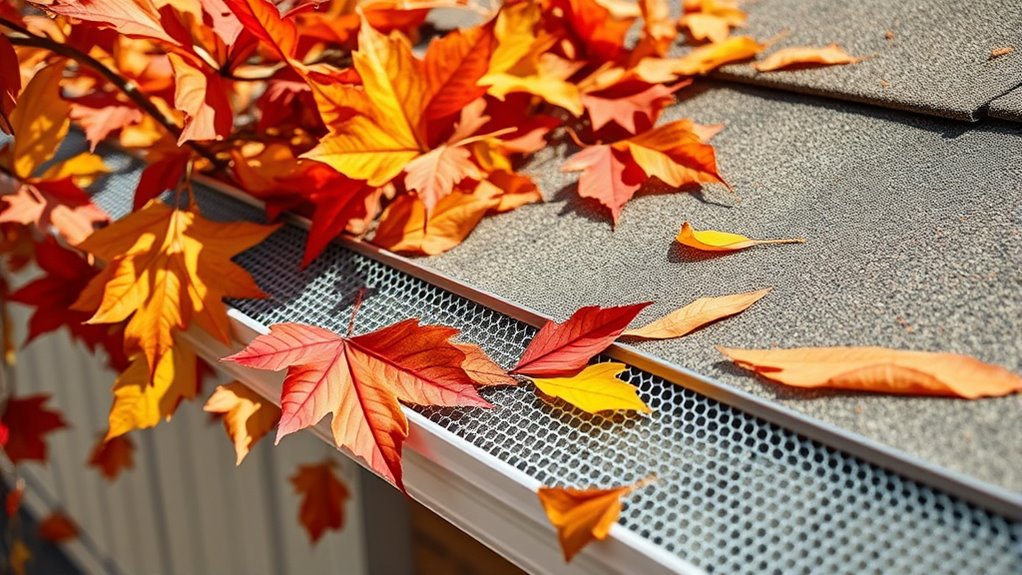To beat leaf season easily, choose gutter guards like mesh screens or reverse-curve styles that block debris while allowing water flow. Mesh screens are affordable and straightforward to install, reducing your maintenance effort, while professional-installed guards offer more coverage. Regular inspections and cleaning after storms ensure your system works smoothly. If you want to learn how the right choice can save you time and hassle during leaf season, keep exploring your options.
Key Takeaways
- Mesh gutter guards are affordable and easy to install, effectively blocking leaves and debris.
- Reverse-curve guards provide thorough coverage but may require professional installation for best results.
- Regular inspections and cleaning of guards ensure optimal performance during leaf season.
- Selecting guards suited to your environment reduces maintenance and prevents gutter clogs.
- Properly chosen gutter guards protect your home from water damage and extend gutter lifespan.

Gutter guards are a practical solution to keep your gutters clear of leaves, debris, and pests. When leaf season arrives, you don’t want to be caught up in constant gutter maintenance or climbing ladders to clear out clogs. Installing gutter guards can substantially reduce the amount of debris that enters your gutters, making leaf prevention much easier. They act as a barrier, allowing rainwater to flow freely while blocking leaves, twigs, and other debris from accumulating. This is especially helpful during fall, when trees shed their leaves in abundance. With gutter guards in place, you won’t need to worry about gutter overflow or water damage caused by clogged gutters. It’s a smart investment that simplifies your seasonal chores and protects your home’s foundation.
Maintaining your gutters becomes far less labor-intensive once you have gutter guards installed. Instead of digging out leaves and gunk after every storm, you can focus on routine inspections to ensure the guards are functioning properly. Regular gutter maintenance is still necessary to check for small debris that may slip through or to clear any blockages caused by dirt or small seeds. But overall, gutter guards drastically cut down on the frequency and difficulty of cleaning. They also help prevent pests like insects and rodents that often make nests in accumulated debris. By reducing debris buildup, gutter guards keep your gutter system healthier and less prone to rust or damage. This means fewer repairs and a longer lifespan for your gutters. Using gutter guard types suited to your home’s environment can further enhance their effectiveness and ease of maintenance.
Choosing the right type of gutter guard depends on your home’s needs and your budget, but the key is to prioritize ease of maintenance and effective leaf prevention. Mesh screens, for example, are popular for their simplicity and affordability, while reverse-curve guards offer more thorough coverage but require professional installation. Whichever option you pick, the goal is to minimize the mess and effort involved in gutter cleaning. Keep in mind that no gutter guard is entirely maintenance-free, but the right choice can make your gutter upkeep much more manageable. Regularly inspect and clean the guards as needed, especially after storms, to ensure they’re functioning properly and providing excellent leaf prevention.
In the end, investing in easy-to-maintain gutter guards means you spend less time battling debris and more time enjoying your home. They’re a practical, effective way to streamline gutter maintenance, especially during leaf season, and help safeguard your property from water damage. With the right setup, you’ll find that gutter cleaning becomes a quick, simple task rather than a dreaded chore. Proper leaf prevention and consistent gutter maintenance will keep your gutters functioning flawlessly, giving you peace of mind every season.
Frequently Asked Questions
How Often Should Gutter Guards Be Cleaned or Maintained?
You should inspect and clean your gutter guards at least twice a year, typically in spring and fall, to maintain peak performance. Your maintenance schedule may require more frequent cleaning if you have lots of trees nearby or experience heavy storms. Regularly check for clogs or debris buildup, and clear them promptly to prevent water damage. Staying on top of cleaning frequency ensures your gutter guards stay effective year-round.
Are Gutter Guards Suitable for All Roof Types?
Imagine you’re living through a hurricane—gutter guards aren’t one-size-fits-all. Thankfully, many options are designed for different roof compatibility and material versatility, making them suitable for most roof types. Whether your roof’s material is asphalt, metal, or tile, you can find a gutter guard that fits. Just be sure to check compatibility to guarantee maximum protection without compromising your roof’s integrity.
Can Gutter Guards Be Installed DIY or Require Professional Help?
You can definitely do DIY installation of gutter guards if you’re comfortable with basic tools and follow the instructions carefully. However, for complex roof types or larger systems, professional assistance might be a better choice to guarantee proper fit and safety. Consider your experience level and the specific gutter guard product to decide whether DIY or professional help works best for you.
How Do Gutter Guards Affect Water Flow During Heavy Rain?
Gutter guards are like a shield during heavy rain, ensuring water flows smoothly. They prevent leaf accumulation that can block water drainage, reducing the risk of overflowing gutters. When installed properly, they help direct water efficiently, even in downpours. However, if debris gets trapped or the guards are clogged, water flow might slow. Regular maintenance keeps your gutter guards working perfectly, keeping your home protected from rain damage.
What Is the Typical Lifespan of Different Gutter Guard Materials?
You can expect different gutter guard materials to last varying lengths of time based on their durability. Aluminum guards typically last 10-20 years, offering good durability with minimal maintenance. Stainless steel guards are more durable, often lasting 20-30 years, but they come at a higher cost. Vinyl options usually need replacement after 5-10 years due to lower material durability. Consider your climate and budget when planning your replacement timeline.
Conclusion
With the right gutter guard, you can breeze through leaf season like a leaf floated effortlessly downstream. These easy-to-install options keep your gutters clear and your mind at ease, preventing clogs before they form. Think of gutter guards as your home’s first line of defense—reliable and steadfast. Don’t wait until leaves pile up; take action now and enjoy a worry-free, tidy roofline all season long. Your home will thank you for the simple, effective upgrade.










